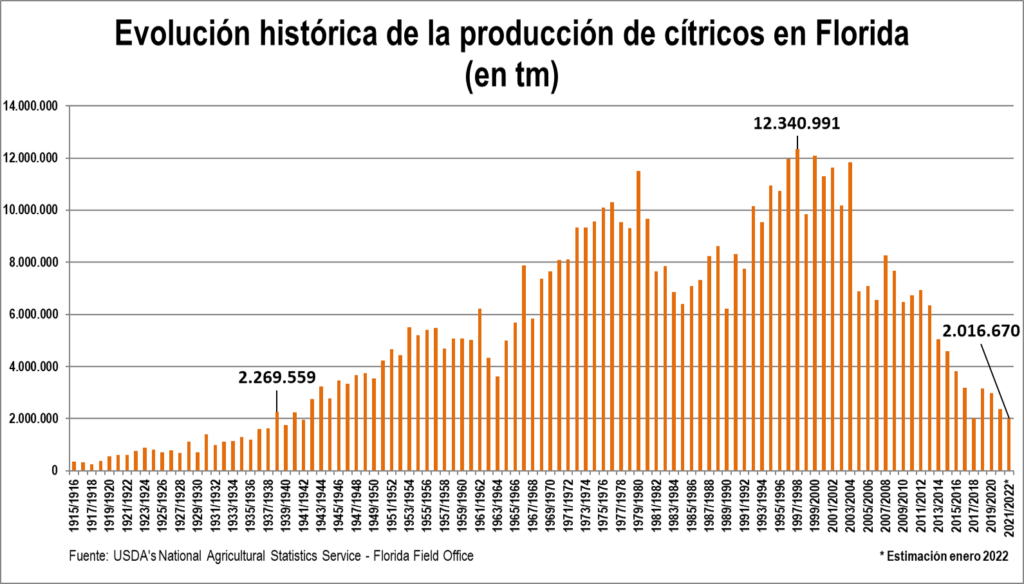- Si este insecto se introdujera, España tendría los dos portadores del Greening (HLB), lo que dispararía la posibilidad de que la enfermedad se detecte y en tal caso la citricultura española podría desaparecer en 15 años.
- En lo que llevamos de siglo ya se han introducido en nuestro país 16 plagas foráneas y en la mayor parte de los casos se han retirado los fitosanitarios para poder combatirlas.
- La interprofesional reitera su exigencia de imponer medidas más garantistas –como el cold treatment– contra las principales amenazas exteriores.
The entire European citrus industry is on high alert after Israeli authorities confirmed the detection of Diaphorina citri in Israel. Authorities confirmed that the Asian psyllid, the insect that carries the most aggressive strain of the greening disease (Huanglongbing or HLB disease) – which is triggered by the bacterium Candidatus Liberibacter asiaticus, had been detected in the country. It is the most devastating citrus disease on the planet, not only because it causes the death of trees but also because there is no known cure. The situation is extremely serious as this insect can adapt to the Mediterranean climate. If it reaches the Peninsula, Spain would be affected by the presence of the two HLB vectors (the Asian psylla that was detected in Israel and the African, Trioza erytreae, an insect that has already been detected from Algarve (the south of Portugal) to the Basque Country. It seems that it’s only a matter of time before the bacteria arrive in the country and spread without remedy. According to a study carried out at the time based on projections of what happened in Florida (USA), under these circumstances, Spanish citriculture would be reduced by half in 7 years and could disappear in less than 15 years. Intercitrus considera que este desafortunado hallazgo es un hito que debería obligar a la Unión Europea a cambiar su política fitosanitaria y aplicar, sin más demora y de forma sistemática, las medidas más garantizadas contra las principales amenazas a la citricultura europea.
The EU will have its first opportunity to do this on January 31 and February 1, when the EU’s Phytosanitary Standing Committee meets to consider what measures to apply to curb the growing threat of the other two most destructive pathogens, according to the EU itself: Thaumatotibia leucotreta and Phyllosticta citricarpa. For the first of them, Intercitrus claims that the EU impose the most effective method known, which already implements China, USA, India, Japan, Australia to imports from third countries … an internationally standardized process and has reduced to nothing interceptions of this disease, because it eliminates all possible larvae housed inside the fruit, which is none other than the ‘cold treatment’ in transit (apply a temperature close to 0 degrees for a certain period). For the second, the interprofessional calls for strengthening the measures at origin that are already being applied to European imports from countries that suffer from this fungus, which would also involve applying protocols similar to those that Spain is obliged to comply with when exporting oranges or mandarins to the aforementioned countries (with a registry of parcels, registry of exporters, of permitted phytosanitary products, absolute traceability of all batches, inspections at origin and controls at destination…).
Intercitrus has been warning for months that, in terms of plant health, is living a limit situation that questions the medium and long term future of this industry. Since the beginning of this century, there have already been 16 foreign pests not present in the EU until then – viruses, bacteria or insects – that have established themselves in Spanish citrus farming. Every year and a few months, as a direct consequence of the intensification of global traffic, the open trade policy of the EU and climate change itself, with increasingly shorter and milder winters, a new pathogen is identified and installed. Pests that increase economic costs and destruction – with hundreds of thousands of tons affected each year and serious environmental damage – for which their development, biological cycle and necessary treatments are unknown. This is happening within the EU – the most restrictive area of the planet in terms of the use of phytosanitary products – and which has also approved the ‘Farm to Fork’ plan that will force agriculture to reduce by 50% in over the next 8 years the few active substances currently authorized.
In 2019, the authorities and public opinion were presented with a study based on the evolution of citrus cultivation in Florida since the HLB arrived in this US state. The study’s conclusions left no room for doubt about the severity of the disease: the production of oranges, tangerines, and lemons would be reduced by half in 7.5 years from its possible entry (going from 7 million tons to 3.6 million tons) and after 15 years, citriculture would become a residual crop, it would disappear”.
The report highlighted how the smallholdings of many farms, the proximity between plantations, the progressive abandonment of fields that are not monitored or cared for and the lack of investment in R & D against this disease would act as decisive factors to accelerate its expansion. However, the impact on a citriculture such as the Spanish one, which is focused on fresh fruit market would be felt soon after the bacterium began to spread because fruit from infected trees cannot be marketed due to the large increase in acidity and bitter taste. Long before the trees die, the fruit would have no possible outlet.
According to the study, the disappearance of the Spanish citrus industry would entail:
- The disappearance of 200,000 direct jobs and 79,000 jobs that are linked to production itself.
- Losing a business that has an average value of 4,000/4,310 million euro per season of which 3,100-3,224 million euros come from exports.
- It would have a great impact on the transport sector: 174,000 trucks of citrus leave through our border each campaign, to which should be added those that distribute the 1.4 million tons that are sold in Spain and the transport of 6.8- 7.3 million tonnes from the field to the warehouses.
- Losses and unemployment in related activities (packaging, pesticides, fertilizers,…)
- In addition, it would have a great ecological impact due to the abandonment and degradation of 300,000 hectares that currently absorb hundreds of thousands of tons of CO₂.
Historical evolution of Florida citrus production before and after the confirmation of the HLB in 2005

